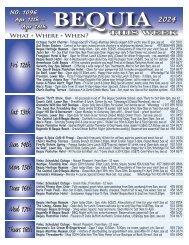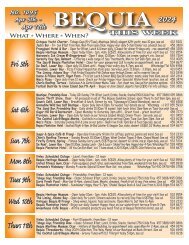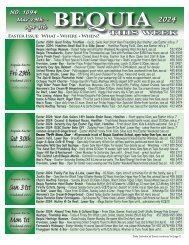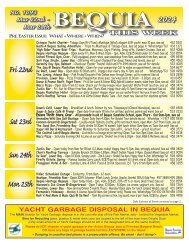Caribbean Compass Yachting Magazine - April 2021
Welcome to Caribbean Compass, the most widely-read boating publication in the Caribbean! THE MOST NEWS YOU CAN USE - feature articles on cruising destinations, regattas, environment, events...
Welcome to Caribbean Compass, the most widely-read boating publication in the Caribbean! THE MOST NEWS YOU CAN USE - feature articles on cruising destinations, regattas, environment, events...
Create successful ePaper yourself
Turn your PDF publications into a flip-book with our unique Google optimized e-Paper software.
— Continued from previous page<br />
• 2005<br />
The 28 storms of the 2005 season began on June 8th and ended with a named<br />
storm tracked to January 6th, 2006 — a seven-month season. Remember, the<br />
official season is from June 1st to November 30th — six months — but storms don’t<br />
follow this rule! As Don Street points out, there have been named storms in May,<br />
December and January.<br />
In 2005 there were 13 tropical storms, eight hurricanes and seven major<br />
hurricanes. Only two storms crossed the islands, both over Grenada (one tropical<br />
storm and one hurricane).<br />
• 2020<br />
Last season saw 30 named storms: 17 tropical storms, eight hurricanes and five<br />
major hurricanes. They were tracked from May 16th to November 18th, 2020.<br />
During this time, as in 2005, only two tropical storms passed through the Eastern<br />
<strong>Caribbean</strong> island chain: one between Trinidad and Grenada, and one over Antigua.<br />
This was in line with average number of storms crossing the islands: two per year<br />
over the last 30 years.<br />
It might be assumed the Eastern <strong>Caribbean</strong> area would be especially vulnerable to<br />
being hit by storms in an active season, as it lies on the border between the Tropical<br />
Atlantic and the <strong>Caribbean</strong> Sea. What we heard last May was that it would be an<br />
“above average” or a “very active season,” but the Eastern <strong>Caribbean</strong> islands didn’t<br />
seem to be any more active than “average.” In the Lesser Antilles, the years 2017<br />
(four storms), 2004 (five storms), and 1995 (four storms) were “very active,” but those<br />
years were only slightly above the average yearly activity for all areas.<br />
So where were all those other storms in the active 1933, 2005 and 2020 years? Not<br />
in the Eastern <strong>Caribbean</strong> islands!<br />
Most of the 1933 and 2005 storms were in the western <strong>Caribbean</strong> and sub-tropical<br />
Atlantic and spread out in those areas. Storms entered northeastern Mexico and the<br />
US coast along the Gulf of Mexico.<br />
The 2020 season had three main tracks: central <strong>Caribbean</strong>, subtropical Atlantic<br />
centered on Bermuda, and a minor branch on the East Coast of the US. Eight storms<br />
formed in the tropical Atlantic east of the islands but only two entered the Lesser<br />
Antilles. The others passed north of the islands into the sub-tropical Atlantic (north<br />
of 20° North). The peak timing was the third week of September — eight storms were<br />
tracked during that week.<br />
Last season saw<br />
30 named storms,<br />
but only two<br />
tropical storms<br />
passed through<br />
the Eastern<br />
<strong>Caribbean</strong> island<br />
chain.<br />
Is there a correlation between how active a season is and where the storms go?<br />
The US National Hurricane Center’s yearly reports discuss the seasons in detail<br />
and the larger factors that determined individual tracks. These factors include<br />
troposphere conditions at the time of formation, sea surface temperatures here and<br />
in the Pacific, and other short- and long-term weather factors. All the influences of<br />
where and when individual storms form could never be predicted for a season.<br />
However, it might be interesting to study whether there is any correlation between<br />
an active season and where that activity is actually concentrated. If there is, maybe<br />
the place to be in an active season is in the Eastern <strong>Caribbean</strong>! That would have<br />
been a good choice in the very active seasons of 1933, 2005 and 2020.<br />
A final note<br />
The US National Hurricane Center issues a five-day tropical forecast that indicates<br />
possible development areas for storms within the next five days. That does not mean<br />
they don’t look beyond five days or are myopic and caught flat-footed looking only at<br />
the next five days. For cruisers planning on longer voyages, many GRIB products like<br />
Windyty and private forecasters are available and will report projections up to ten<br />
days or more based on the same NOAA data the NHC uses.<br />
Fortunately, the Lesser Antilles were spared the impact of a major hurricane last<br />
season. The pandemic was enough of a disruption! Apparently the “active season”<br />
resulted in more areas being vulnerable to a storm, but the Lesser Antilles did not<br />
experience an increase in named storms.<br />
It should also be recognized that the effects of hurricanes extend much wider than<br />
the actual track across one island. “ROW” effects — Rain (flooding, landslides and<br />
erosion), Ocean (storm surge, swell and high seas), and Wind (damage to structures<br />
and powerlines, and flying debris) — can be widespread and across many islands.<br />
As mentioned in the beginning, my wife and I spent the 2020 hurricane season<br />
aboard our boat in Rodney Bay, St. Lucia, both anchored in the bay and in a slip at<br />
the marina. This was our first season “inside the box” and so we kept an active<br />
hurricane eye on the horizon. The pandemic slowed us down as far as traveling<br />
around the island, but we enjoyed being “stuck” in paradise.<br />
Overall, and reviewing the above, spending the hurricane season in the Lesser<br />
Antilles was not as daunting as was imagined. Rodney Bay Marina is well protected<br />
and we felt very secure. You can also have your boat hauled out and secured on the<br />
hard but we decided to stay in the water. This gave us the option of sailing south if a<br />
major hurricane threatened. All the weather forecasts were timely and accurate, so<br />
even if a quickly developing storm came along there would have been time to react.<br />
The limiting restrictions of the pandemic were more of a hindrance than the weather.<br />
Locals and cruisers never gave us any hint that this was a dangerous time (despite<br />
the pandemic). Without the pandemic, sailing the Lesser Antilles during the<br />
hurricane season would not be out of the question. Fewer cruisers and calmer<br />
tradewinds are some of the advantages.<br />
Were we lucky? Perhaps. Hurricanes are dangerous. But until long-range forecasts<br />
of where storms are more likely to form are available, the best advice remains: be<br />
alert and always be where hurricanes are not. Also, check out Don Street’s website<br />
(www.street-iolaire.com) for great hurricane advice if one is heading your way.<br />
APRIL <strong>2021</strong> CARIBBEAN COMPASS PAGE 15<br />
Bill and Maureen Woodroffe sail aboard S/V Kalunamoo.<br />
Visit their blog at http://Kalunamoo.com.

















